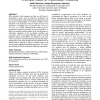Free Online Productivity Tools
i2Speak
i2Symbol
i2OCR
iTex2Img
iWeb2Print
iWeb2Shot
i2Type
iPdf2Split
iPdf2Merge
i2Bopomofo
i2Arabic
i2Style
i2Image
i2PDF
iLatex2Rtf
Sci2ools
CHI
2010
ACM
2010
ACM
A simple index for multimodal flexibility
Most interactive tasks engage more than one of the user’s exteroceptive senses and are therefore multimodal. In real-world situations with multitasking and distractions, the key aspect of multimodality is not which modalities can be allocated to the interactive task but which are free to be allocated to something else. We present the multimodal flexibility index (MFI), calculated from changes in users’ performance induced by blocking of sensory modalities. A high score indicates that the highest level of performance is achievable regardless of the modalities available and, conversely, a low score that performance will be severely hampered unless all modalities are allocated to the task. Various derivatives describe unimodal and bimodal effects. Results from a case study (mobile text entry) illustrate how an interface that is superior to others in absolute terms is the worst from the multimodal flexibility perspective. We discuss the suitability of MFI for evaluation of interactive...
CHI 2010 | Human Computer Interaction | Interactive Task | Multimodal Flexibility | Multimodal Flexibility Index |
| Added | 17 May 2010 |
| Updated | 17 May 2010 |
| Type | Conference |
| Year | 2010 |
| Where | CHI |
| Authors | Antti Oulasvirta, Joanna Bergstrom-Lehtovirta |
Comments (0)

